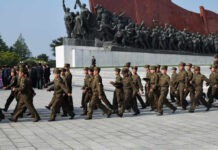
A new wave of Russian military aggression threatens the stability of Ukraine’s energy infrastructure, drawing international criticism and calls for heightened sanctions.
Story Highlights
- Russian forces targeted Ukraine’s energy infrastructure, causing widespread power outages.
- Over one million households in Kyiv and nine regions were affected by the attack.
- Ukraine’s emergency crews restored power, demonstrating resilience amid crisis.
- Western leaders plan to use frozen Russian assets to support Ukraine.
Russian Assault on Ukraine’s Energy Infrastructure
On October 10, 2025, Russian forces launched a massive drone and missile attack against Ukraine’s energy infrastructure, leading to significant power outages across Kyiv and nine other regions. This operation was part of a broader strategy to deprive civilians of essential services as winter approaches. The attack, involving advanced Kinzhal hypersonic missiles, represents one of the largest concentrated strikes, according to Ukrainian Prime Minister Yulia Svyrydenko. The assault knocked out electricity for over one million homes and businesses, disrupted metro services, and resulted in civilian casualties, including a seven-year-old child.
Emergency crews, led by Ukraine’s largest private energy firm DTEK, worked tirelessly to restore power. By Friday evening, electricity was reportedly restored to all Kyiv residents, though localized outages persisted. The attack underscores Russia’s ongoing strategy to weaponize energy infrastructure, aiming to erode public morale as temperatures plummet.
Watch: Russia Strikes Kyiv Apartments, Energy Sites in Massive Assault, Power Cuts Hit Capital | APT
International Response and Ongoing Developments
Ukraine’s President Volodymyr Zelensky condemned the strikes as a “record for villainy” and called for increased Western sanctions against Moscow. In response, leaders from Britain, France, and Germany agreed to use frozen Russian assets to support Ukraine’s armed forces, aiming to increase pressure on President Vladimir Putin. This coordinated diplomatic move highlights the international community’s commitment to Ukraine’s defense and sovereignty.
Despite these efforts, the attacks continued into Saturday, targeting the Odesa region and affecting 240,000 households. DTEK managed to restore power swiftly, but the ongoing threat of further strikes looms large as the winter season begins. The Ukrainian Air Force intercepted 54 of 78 drones, reflecting the challenges of defending against technologically advanced attacks.
Implications and Future Outlook
The repeated targeting of energy infrastructure has severe humanitarian implications, affecting millions of civilians who rely on consistent energy supply for heating and water during harsh winter conditions. The psychological impact is profound, as residents endure sleepless nights and the uncertainty of further disruptions. Economically, the attacks strain both private and public resources, with repair costs accumulating and impacting productivity.
As the conflict enters its fourth winter, the use of advanced weaponry like Kinzhal missiles indicates a possible escalation in attack intensity. The international community’s response, leveraging economic sanctions and frozen assets, seeks to deter further aggression and bring Russia to the negotiating table. However, the fundamental disagreement over the legality and morality of these strikes continues to complicate diplomatic efforts.
Sources:
Arab News: Power Being Restored After Russian Attack Plunges Thousands in Kyiv Into Darkness
The Independent: Ukraine’s Energy Grid Under Attack Amidst Russian Strikes
The Moscow Times: Russian Attack Cuts Power to Parts of Ukraine’s Odesa Region

























